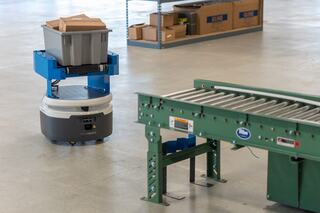Worldwide Leader Automates Order Fulfillment Center with Autonomous Mobile Robotics (AMR)
With dozens of snack brands, over 50,000 employees, and warehouse expansions across the United States, a worldwide leader in the food and beverage industry has long understood the importance of integrated automation. The next frontier? Autonomous mobile robotics.

Business Challenge
The company opened a massive warehouse in the southeast for direct-to-store order fulfillment. The warehouse was equipped with snack containers, custom wheeled racks, a case erector, an autostore system, and a crowded shipping and receiving area.
Despite the relatively small size of the new plant, the food distributor had 10 human employees to manage the order fulfillment process.
Employees would fulfill orders, verify and sort large volumes of snack products, load them onto wheeled racks, then transfer each rack to the autostore or shipping area for final boxing, labeling, and loading. The issue: finding enough labor to operate, especially in peak season.
Not only were wages much higher, the volume and quality of skilled candidates for running a major order fulfillment warehouse left much to be desired.
The Solution
A proper automation pilot was necessary in order for the direct-to store distribution model to succeed. After 3 days of onsite visits, a careful ROI calculation based on customer processes and data points, and weighing the pros and cons of different AMR options, the Levata Solution Architecture team recognized a need for a special robot.
This AMR would not only need to fit beneath the custom carts in the warehouse, but also make the sorting, storing, and fulfillment process much smoother. The AMR also had to easily integrate with the case erector, robotic arms for picking up products, autostore dropoff, and shipping (as well as with the existing ERP and WMS).
Levata recommended a work cell delivery AMR to be used in conjunction with SVT fleet management software.
After completion of a successful 3 week pilot, the AMR was the ideal tool for the job. With seamless plug-and-play installation, as well as a custom AMR fleet management software, this integration addressed both their labor challenges and improved the workflow for the entire distribution center.
Benefits and Results
Instead of hiring, training, paying, and managing 10 people to move things around the facility from A to B, a single AMR was implemented for the entire fulfillment process.
The newly integrated AMR system improved direct-to-store delivery output, reduced the number of workers involved from ten to one, and made a complicated process much simpler. A single AMR can fully pay for itself in less than 12 months since inception.
Levata's fleet management software communicates with other technology already in place – regardless of the AMR manufacturer.
In the long term, the company is planning to scale the AMR integration to other locations around the world.
- Industry
Warehousing & Distribution
- Capability
Automation with Vision & Robotics
- Application
Order Fulfillment
- Challenge
Labor shortage and cost to move products manually from A to B was not sustainable
- Featured Solution
Integrated AMR to be used in conjunction with fleet management software
- Key Benefits
Improved delivery output, reduced number of workers required from ten to one, and made automation easier to scale to more locations
The Levata approach to automation was transformative. Not only did they design the right solution for my needs, but they also managed the deployment and integration onsite, and continued to support the solution after go-live.